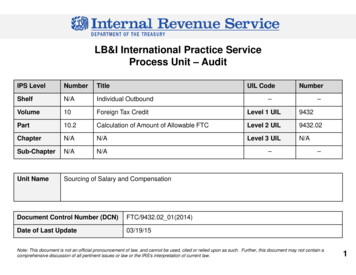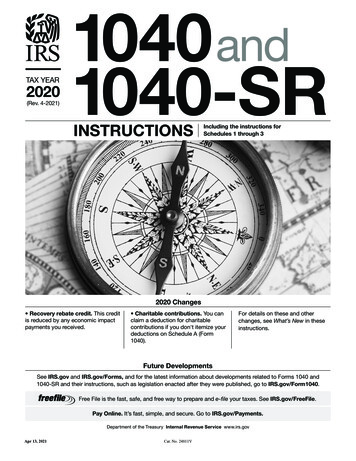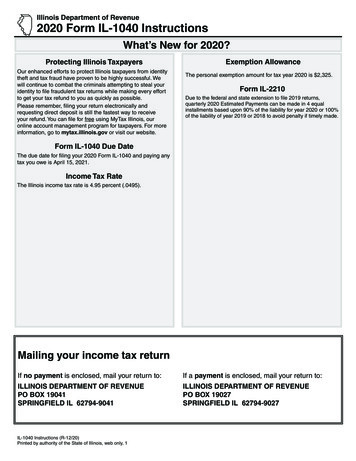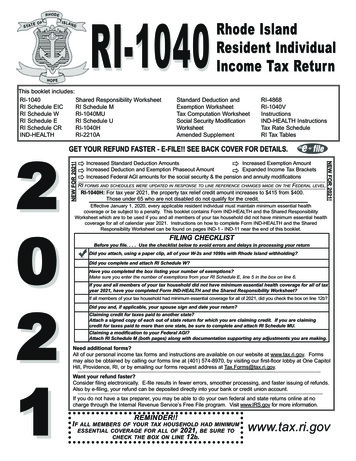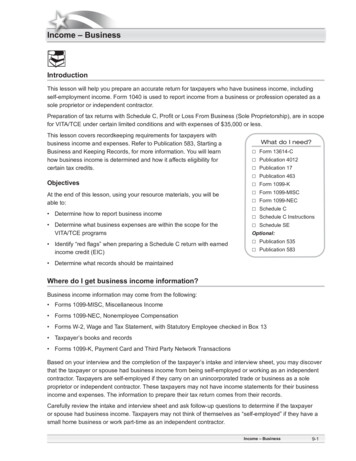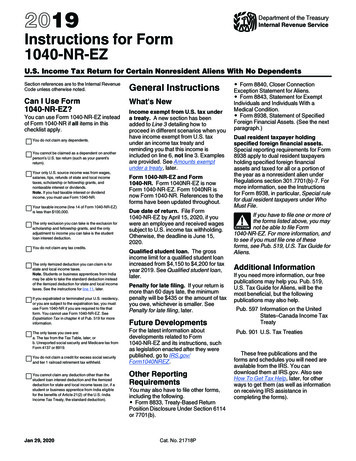
Transcription
2019Department of the TreasuryInternal Revenue ServiceInstructions for Form1040-NR-EZU.S. Income Tax Return for Certain Nonresident Aliens With No DependentsSection references are to the Internal RevenueCode unless otherwise noted.General InstructionsCan I Use Form1040-NR-EZ?What's NewYou can use Form 1040-NR-EZ insteadof Form 1040-NR if all items in thischecklist apply.You do not claim any dependents.You cannot be claimed as a dependent on anotherperson's U.S. tax return (such as your parent'sreturn).Your only U.S. source income was from wages,salaries, tips, refunds of state and local incometaxes, scholarship or fellowship grants, andnontaxable interest or dividends.Note. If you had taxable interest or dividendincome, you must use Form 1040-NR.Your taxable income (line 14 of Form 1040-NR-EZ)is less than 100,000.The only exclusion you can take is the exclusion forscholarship and fellowship grants, and the onlyadjustment to income you can take is the studentloan interest deduction.You do not claim any tax credits.The only itemized deduction you can claim is forstate and local income taxes.Note. Students or business apprentices from Indiamay be able to take the standard deduction insteadof the itemized deduction for state and local incometaxes. See the instructions for line 11, later.If you expatriated or terminated your U.S. residency,or you are subject to the expatriation tax, you mustuse Form 1040-NR if you are required to file thatform. You cannot use Form 1040-NR-EZ. SeeExpatriation Tax in chapter 4 of Pub. 519 for moreinformation.The only taxes you owe are:a. The tax from the Tax Table, later; orb. Unreported social security and Medicare tax fromForm 4137 or 8919.You do not claim a credit for excess social securityand tier 1 railroad retirement tax withheld.You cannot claim any deduction other than thestudent loan interest deduction and the itemizeddeduction for state and local income taxes (or, if astudent or business apprentice from India eligiblefor the benefits of Article 21(2) of the U.S.-IndiaIncome Tax Treaty, the standard deduction).Jan 29, 2020Income exempt from U.S. tax undera treaty. A new section has beenadded to Line 3 detailing how toproceed in different scenarios when youhave income exempt from U.S. taxunder an income tax treaty andreminding you that this income isincluded on line 6, not line 3. Examplesare provided. See Amounts exemptunder a treaty, later.Form 1040-NR-EZ and Form1040-NR. Form 1040NR-EZ is nowForm 1040-NR-EZ. Form 1040NR isnow Form 1040-NR. References to theforms have been updated throughout.Due date of return. File Form1040-NR-EZ by April 15, 2020, if youwere an employee and received wagessubject to U.S. income tax withholding.Otherwise, the deadline is June 15,2020.Qualified student loan. The grossincome limit for a qualified student loanincreased from 4,150 to 4,200 for taxyear 2019. See Qualified student loan,later.Penalty for late filing. If your return ismore than 60 days late, the minimumpenalty will be 435 or the amount of taxyou owe, whichever is smaller. SeePenalty for late filing, later.Future DevelopmentsFor the latest information aboutdevelopments related to Form1040-NR-EZ and its instructions, suchas legislation enacted after they werepublished, go to IRS.gov/Form1040NREZ.Other ReportingRequirementsYou may also have to file other forms,including the following. Form 8833, Treaty-Based ReturnPosition Disclosure Under Section 6114or 7701(b).Cat. No. 21718P Form 8840, Closer ConnectionException Statement for Aliens. Form 8843, Statement for ExemptIndividuals and Individuals With aMedical Condition. Form 8938, Statement of SpecifiedForeign Financial Assets. (See the nextparagraph.)Dual resident taxpayer holdingspecified foreign financial assets.Special reporting requirements for Form8938 apply to dual resident taxpayersholding specified foreign financialassets and taxed for all or a portion ofthe year as a nonresident alien underRegulations section 301.7701(b)-7. Formore information, see the Instructionsfor Form 8938, in particular, Special rulefor dual resident taxpayers under WhoMust File.If you have to file one or more ofthe forms listed above, you mayCAUTION not be able to file Form1040-NR-EZ. For more information, andto see if you must file one of theseforms, see Pub. 519, U.S. Tax Guide forAliens.!Additional InformationIf you need more information, our freepublications may help you. Pub. 519,U.S. Tax Guide for Aliens, will be themost beneficial, but the followingpublications may also help.Pub. 597 Information on the UnitedStates–Canada Income TaxTreatyPub. 901 U.S. Tax TreatiesThese free publications and theforms and schedules you will need areavailable from the IRS. You candownload them at IRS.gov. Also seeHow To Get Tax Help, later, for otherways to get them (as well as informationon receiving IRS assistance incompleting the forms).
Resident Alien orNonresident AlienIf you are not a citizen of the UnitedStates, specific rules apply to determineif you are a resident alien or anonresident alien for tax purposes.Generally, you are considered aresident alien if you meet either thegreen card test or the substantialpresence test for 2019. (These tests areexplained in Green Card Test next andSubstantial Presence Test, later.) Evenif you do not meet either of these tests,you may be able to choose to be treatedas a U.S. resident for part of 2019. SeeFirst-Year Choice in chapter 1 of Pub.519 for details.Generally, you are considered anonresident alien for the year if you arenot a U.S. resident under either of thesetests. However, see Dual-ResidentTaxpayer, later, if you are a resident ofthe United States under these tests butare eligible to claim benefits as aresident of a foreign country under aU.S. income tax treaty.For more details on resident andnonresident status, the tests forresidence, and the exceptions to them,see chapter 1 of Pub. 519.Green Card TestYou are a resident for tax purposes ifyou were a lawful permanent resident(immigrant) of the United States at anytime during 2019. (However, seeDual-Status Taxpayers, later.) In mostcases, you are a lawful permanentresident if the U.S. Citizenship andImmigration Services (USCIS) (or itspredecessor organization, INS) hasissued you an alien registration card,also known as a green card.You continue to have resident statusunder this test unless the status is takenaway from you or is administratively orjudicially determined to have beenabandoned.Your resident status is considered tohave been taken away from you if theU.S. Government issues you a finaladministrative or judicial order ofexclusion or deportation. When yourresident status is considered to havebeen administratively or judiciallydetermined to be abandoned dependson who initiates the determination.If the USCIS or U.S. consular officerinitiates this determination, yourresident status will be considered to beabandoned when the finaladministrative order of abandonment isissued.If you initiate the determination, yourresident status is considered to beabandoned when you file either of thefollowing documents—along with yourUSCIS Alien Registration ReceiptCard—with the USCIS or a U.S.consular officer. USCIS Form I-407, Record ofAbandonment of Lawful PermanentResident Status. A letter stating your intent to abandonyour resident status.The USCIS Alien RegistrationReceipt Card is also referred to as agreen card.When filing by mail, you must sendyour filing by certified mail, returnreceipt requested (or the foreignequivalent) and keep a copy and proofthat it was mailed and received.Until you have proof your letterwas received, you remain aCAUTION resident for tax purposes even ifthe USCIS would not recognize thevalidity of your green card because it ismore than 10 years old or because youhave been absent from the UnitedStates for a period of time.!For more details, including specialrules that apply if you give up your greencard after holding it in at least 8 of theprior 15 years, see Pub. 519.Substantial Presence TestYou are considered a U.S. resident ifyou meet the substantial presence testfor 2019. You meet this test if you werephysically present in the United Statesfor at least:1. 31 days during 2019; and2. 183 testing days during theperiod 2019, 2018, and 2017, using thefollowing chart.(a)Year(b)Days 0170.167(d)Testingdays(multiply(b) times(c))Total testing days (add column(d)) . . . . . . . . . . . . . . . .Generally, you are treated as presentin the United States on any day that youare physically present in the country atany time during the day. However, thereare exceptions to this rule. In general,do not count the following as days of-2-presence in the United States for thesubstantial presence test.1. Days you commute to work in theUnited States from a residence inCanada or Mexico if you regularlycommute from Canada or Mexico.2. Days you are in the United Statesfor less than 24 hours when you are intransit between two places outside theUnited States.3. Days you were temporarily in theUnited States as a regular crew memberof a foreign vessel engaged intransportation between the UnitedStates and a foreign country or apossession of the United States unlessyou otherwise engaged in trade orbusiness on such day.4. Days you intend, but are unable,to leave the United States because of amedical condition that arose while youwere in the United States.5. Days you are in the United Statesunder a NATO visa as a member of aforce or civilian component to NATO.However, this exception does not applyto an immediate family member who ispresent in the United States under aNATO visa. A dependent familymember must count every day ofpresence for purposes of the substantialpresence test.6. Days you are an exemptindividual (defined next).You may need to file Form 8843to exclude days of presence inCAUTION the United States if you meet (4)or (6) above. For more information onthe requirements, see Form 8843 inchapter 1 of Pub. 519.!Exempt individual. For purposes ofthe substantial presence test, anexempt individual is generally anindividual who is a: Foreign government-relatedindividual; Teacher or trainee who is temporarilypresent under a “J” or “Q” visa; Student who is temporarily presentunder an “F,” “J,” “M,” or “Q” visa; or Professional athlete who istemporarily in the United States tocompete in a charitable sports event.Note. Alien individuals with “Q” visasare treated as either students, teachers,or trainees and, as such, are exemptindividuals for purposes of thesubstantial presence test if theyotherwise qualify. “Q” visas are issuedto aliens participating in certaininternational cultural exchangeprograms.Instructions for Form 1040-NR-EZ (2019)
See chapter 1 of Pub. 519 for moredetails regarding days of presence inthe United States for the substantialpresence test.You cannot be an exemptindividual indefinitely. Generally,CAUTION you will not be an exemptindividual as a teacher or trainee in2019 if you were exempt as a teacher,trainee, or student for any part of 2 ofthe preceding 6 calendar years. You willnot be an exempt individual as a studentin 2019 if you were exempt as ateacher, trainee, or student for any partof more than 5 calendar years.However, there are exceptions to theselimits. See Substantial Presence Test inchapter 1 of Pub. 519 for moreinformation.!Closer Connection to ForeignCountrytreated as a nonresident of the UnitedStates for purposes of figuring out yourincome tax liability if you file a Form1040-NR-EZ by the due date of thereturn (see When To File, later) andattach a Form 8833, Treaty-BasedReturn Position Disclosure UnderSection 6114 or 7701(b). Adual-resident taxpayer who does nottimely file Form 1040-NR-EZ may beeligible for U.S. competent authorityassistance. See Rev. Proc. 2015-40,2015-35 I.R.B. 236, or its successor.You can download the complete text ofmost U.S. tax treaties at IRS.gov. Go toIRS.gov, enter “tax treaties” in thesearch box at the top of the page, andclick on United States Income TaxTreaties - A to Z. Technical explanationsfor many of those treaties are alsoavailable at that site.If you file after the due date (withoutextensions), you may have to payinterest and penalties. See Interest andPenalties, later.Who Must FileWhere To FileEven though you otherwise would meetthe substantial presence test, you canbe treated as a nonresident alien if you: Were present in the United States forfewer than 183 days during 2019, Establish that during 2019 you had atax home in a foreign country, and Establish that during 2019 you had acloser connection to one foreign countryin which you had a tax home than to theUnited States unless you had a closerconnection to two foreign countries.File Form 1040-NR-EZ (or Form1040-NR) if you were a nonresidentalien engaged in a trade or business inthe United States during 2019. Youmust file even if: You have no income from a trade orbusiness conducted in the UnitedStates, You have no income from U.S.sources, or Your income is exempt from U.S. taxunder a tax treaty or any section of theInternal Revenue Code.You are not eligible for the closerconnection exception if you have anapplication pending for adjustment ofstatus to that of a lawful permanentresident or if you have applied, or havetaken other steps to apply, for lawfulpermanent residence.Other situations when you must file.You must also file a return for 2019 ifyou need to pay social security andMedicare tax on tips you did not reportto your employer or on wages youreceived from an employer who did notwithhold these taxes.See chapter 1 of Pub. 519 for moreinformation.You must file a fully completed Form8840 with the IRS to claim the closerconnection exception. Each spousemust file a separate Form 8840 to claimthe closer connection exception. SeeForm 8840 in chapter 1 of Pub. 519.Dual-Resident TaxpayerYou are a dual-resident taxpayer if youare a resident of both the United Statesand a foreign country under eachcountry's tax laws. If the income taxtreaty between the United States andthat foreign country contains a provisionfor resolving conflicting claims ofresidence (often referred to as“tie-breaker” rules), and you determinethat you are a resident of the foreigncountry under that provision, you can beInstructions for Form 1040-NR-EZ (2019)Exception. You do not need to fileForm 1040-NR-EZ (or Form 1040-NR) ifyou meet the following exception. Youwere a nonresident alien student,teacher, or trainee who was temporarilypresent in the United States under an“F,” “J,” “M,” or “Q” visa, and you haveno income (such as wages, salaries,tips, etc., or scholarship or fellowshipgrants) that is subject to tax undersection 871.When To FileIf you were an employee and receivedwages subject to U.S. income taxwithholding, file Form 1040-NR-EZ byApril 15, 2020.If you did not receive wages as anemployee subject to U.S. income taxwithholding, file Form 1040-NR-EZ byJune 15, 2020.-3-Extension of time to file. If youcannot file your return by the due date,file Form 4868 to get an automatic6-month extension of time to file. Youmust file Form 4868 by the regular duedate of the return. Instead of filing Form4868, you can apply for an automaticextension by making an electronicpayment by the due date of your return.An automatic 6-monthextension of time to file does notCAUTION extend the time to pay your tax.If you do not pay your tax by the originaldue date of your return, you will oweinterest on the unpaid tax and may owepenalties. See Form 4868.!If you are not enclosing a payment, mailForm 1040-NR-EZ to:Department of the TreasuryInternal Revenue ServiceAustin, TX 73301-0215U.S.A.If enclosing a payment, mail Form1040-NR-EZ to:Internal Revenue ServiceP.O. Box 1303Charlotte, NC 28201-1303U.S.A.Private Delivery ServicesYou can use certain private deliveryservices (PDS) designated by the IRS tomeet the “timely mailing as timely filing”rule for tax returns. Go to IRS.gov/PDSfor the current list of designatedservices.The PDS can tell you how to getwritten proof of the mailing date.For the IRS mailing address to use ifyou're using PDS, go to IRS.gov/PDSStreetAddresses.PDS cannot deliver items to IRSP.O. boxes. You must use theCAUTION U.S. Postal Service to mail anyitems to an IRS P.O. box address.!Election To Be Taxed as aResident AlienYou can elect to be taxed as a U.S.resident for the whole year if all of thefollowing apply. You were married.
Your spouse was a U.S. citizen orresident alien on the last day of the taxyear. You file a joint return for the year ofthe election using Form 1040 or1040-SR.To make this election, you mustattach the statement described underNonresident Spouse Treated as aResident in chapter 1 of Pub. 519 toyour return. Do not use Form1040-NR-EZ or 1040-NR.If you make the election to be treatedas a resident alien, your worldwideincome for the whole year must beincluded and will be taxed under U.S.tax laws. You must agree to keep therecords, books, and other informationneeded to figure the tax. If you made theelection in an earlier year, you can file ajoint return or separate return for 2019. Ifyou file a separate return, use Form1040 or 1040-SR. You must includeyour worldwide income for the wholeyear whether you file a joint or separatereturn.If you make this election, youmay forfeit the right to claimCAUTION benefits otherwise availableunder a U.S. tax treaty. For moreinformation about the benefits thatotherwise might be available, see thespecific treaty.!Dual-Status TaxpayersIf you elect to be taxed as aresident alien (discussed earlierCAUTION under Election To Be Taxed asa Resident Alien), the specialinstructions and restrictions discussedhere do not apply.!Dual-Status YearA dual-status year is one in which youchange status between nonresident andresident alien. Different U.S. income taxrules apply to each status.Most dual-status years are the yearsof arrival or departure. Before you arrivein the United States, you are anonresident alien. After you arrive, youmay or may not be a resident,depending on the circumstances.If you become a U.S. resident, youstay a resident until you leave theUnited States or are no longer a lawfulpermanent resident of the UnitedStates. You may become a nonresidentalien when you leave if you meet both ofthe following conditions. After leaving (or after your last day oflawful permanent residency if you metthe green card test, defined earlier) andfor the remainder of the calendar year ofyour departure, you have a closerconnection to a foreign country than tothe United States. During the next calendar year, youare not a U.S. resident under either thegreen card test or the substantialpresence test.See Pub. 519 for more information.What and Where To File for aDual-Status YearIf you were a U.S. resident on the lastday of the tax year, file Form 1040 or1040-SR. Enter “Dual-Status Return”across the top and attach a statementshowing your income for the part of theyear you were a nonresident. You canuse Form 1040-NR-EZ as thestatement; enter “Dual-StatusStatement” across the top. Do not signForm 1040-NR-EZ. If you are notenclosing a payment, mail your returnand statement to the following address.Department of the TreasuryInternal Revenue ServiceAustin, TX 73301-0215U.S.A.If enclosing a payment, mail yourreturn and statement to the followingaddress.Internal Revenue ServiceP.O. Box 1303Charlotte, NC 28201-1303U.S.A.If you were a nonresident on the lastday of the tax year, file Form1040-NR-EZ. Enter “Dual-StatusReturn” across the top and attach astatement showing your income for thepart of the year you were a U.S.resident. You can use Form 1040 or1040-SR as the statement; enter“Dual-Status Statement” across the top.Do not sign Form 1040 or 1040-SR. Ifyou are not enclosing a payment, mailyour return and statement to thefollowing address.Department of the TreasuryInternal Revenue ServiceAustin, TX 73301-0215U.S.A.If enclosing a payment, mail yourreturn and statement to the followingaddress.Internal Revenue ServiceP.O. Box 1303Charlotte, NC 28201-1303U.S.A.-4-Statements. Any statement you filewith your return must show your name,address, and identifying number (seeIdentifying Number, later).Income Subject to Tax forDual-Status YearAs a dual-status taxpayer not filing ajoint return, you are taxed on incomefrom all sources for the part of the yearyou were a resident alien. Generally,you are taxed on income only from U.S.sources for the part of the year you werea nonresident alien. However, allincome effectively connected with theconduct of a trade or business in theUnited States is taxable.Income you received as a dual-statustaxpayer from sources outside theUnited States while a resident alien istaxable even if you became anonresident alien after receiving it andbefore the close of the tax year.Conversely, income you received fromsources outside the United States whilea nonresident alien is not taxable inmost cases even if you became aresident alien after receiving it andbefore the close of the tax year. Incomefrom U.S. sources is generally taxablewhether you received it while anonresident alien or a resident alien(unless specifically exempt under theInternal Revenue Code or a tax treatyprovision).Restrictions for Dual-StatusTaxpayersStandard deduction. You cannot takethe standard deduction even for the partof the year you were a resident alien.Head of household. You cannot usethe Head of household Tax Tablecolumn in the Instructions for Forms1040 and 1040-SR.Joint return. You cannot file a jointreturn unless you elect to be taxed as aresident alien (see Election To BeTaxed as a Resident Alien, earlier)instead of as a dual-status taxpayer.Tax rates. If you were married and anonresident of the United States for allor part of the tax year and you do notmake the election discussed earlier tobe taxed as a resident alien, you mustuse the Married filing separately TaxTable column to figure your tax onincome effectively connected with aU.S. trade or business. If you weremarried, you cannot use the Single TaxTable column.Deduction for exemptions. Thepersonal exemption deduction isInstructions for Form 1040-NR-EZ (2019)
suspended for individuals. You may notclaim a personal exemption in 2019.Tax credits. You cannot take theearned income credit, the credit for theelderly or disabled, or any educationcredit unless you elect to be taxed as aresident alien (see Election To BeTaxed as a Resident Alien, earlier)instead of as a dual-status taxpayer. Forinformation on other credits, seechapter 6 of Pub. 519.How To Figure Tax for aDual-Status YearWhen you figure your U.S. tax for adual-status year, you are subject todifferent rules for the part of the yearyou were a resident and the part of theyear you were a nonresident.All income for the period of residenceand all income that is effectivelyconnected with a trade or business inthe United States for the period ofnonresidence, after allowabledeductions, is combined and taxed atthe same rates that apply to U.S.citizens and residents.Credit for taxes paid. You are alloweda credit against your U.S. income taxliability for certain taxes you paid, or areconsidered to have paid, or that werewithheld from your income. Theseinclude the following.1. Taxes withheld from wages earnedin the United States and taxeswithheld at the source fromscholarship income from U.S.sources.When filing Form 1040 or1040-SR, show the total taxwithheld on line 17. Enter amountsfrom the attached statement (Form1040-NR-EZ, lines 18a and 18b) inthe column to the right of line 17and identify and include them inthe amount on line 17.When filing Form 1040-NR-EZ,show the total tax withheld on lines18a and 18b. Enter the amountfrom the attached statement (Form1040 or 1040-SR, line 17) in thecolumn to the right of line 18a, andidentify and include it in the amounton line 18a.2. Estimated tax paid with Form1040-ES or Form 1040-ES (NR).3. Tax paid with Form 1040-C at thetime of departure from the UnitedStates. When filing Form 1040 or1040-SR, include the tax paid withForm 1040-C with the totalpayments on line 19. Identify thepayment in the area to the left ofthe entry.Line Instructions forForm 1040-NR-EZName and AddressEnter your name, street address, city ortown, and country on the appropriatelines. Include an apartment numberafter the street address, if applicable.P.O. box. Enter your box number only ifyour post office does not deliver mail toyour home.Foreign address. If you have a foreignaddress, enter the city name on theappropriate line. Do not enter any otherinformation on that line, but alsocomplete the spaces below that line.Country name. Do not abbreviatethe country name. Enter the name inuppercase letters in English. Follow thecountry's practice for entering the postalcode and the name of the province,county, or state.Address change. If you plan to moveafter filing your return, use Form 8822,Instructions for Form 1040-NR-EZ (2019)-5-Change of Address, to notify the IRS ofyour new address.Name change. If you changed yourname because of marriage, divorce,etc., and your identifying number is asocial security number, be sure to reportthe change to the Social SecurityAdministration (SSA) before filing yourreturn. This prevents delays inprocessing your return and issuingrefunds. It also safeguards your futuresocial security benefits. See Socialsecurity number (SSN) below for how tocontact the SSA.Death of a taxpayer. See Death of aTaxpayer, later.Identifying NumberAn incorrect or missing identifyingnumber can increase your tax, reduceyour refund, or delay your refund.Social security number (SSN). Inmost cases, you are required to enteryour SSN. If you do not have an SSNbut are eligible to get one, you shouldapply for it. Get Form SS-5, Applicationfor a Social Security Card, online atSSA.gov/ssnumber, from your localSocial Security Administration (SSA)office, or by calling the SSA at800-772-1213. For those who are deafor hard of hearing, or have a speechdisability and have access to TTY/TDDequipment, call 800-325-0778.Fill in Form SS-5 and bring it to yourlocal SSA office in person, along withoriginal documentation showing yourage, identity, immigration status, andauthority to work in the United States. Ifyou are an F-1 or M-1 student, you mustalso show your Form I-20. If you are aJ-1 exchange visitor, you must alsoshow your Form DS-2019. It usuallytakes about 2 weeks to get an SSNonce the SSA has all the evidence andinformation it needs.Check that both the name and SSNon your Forms 1040-NR-EZ, W-2, and1099 agree with your social securitycard. If they do not, certain deductionsand credits on your Form 1040-NR-EZmay be reduced or disallowed and youmay not receive credit for your socialsecurity earnings. If your Form W-2shows an incorrect SSN or name, notifyyour employer or the form-issuing agentas soon as possible to make sure yourearnings are credited to your socialsecurity record. If the name or SSN onyour social security card is incorrect,call the SSA at 800-772-1213 or go to
ur-social-security-card/for more information.IRS individual taxpayer identificationnumber (ITIN). If you do not have andare not eligible to get an SSN, you mustenter your ITIN whenever an SSN isrequested on your tax return.For details on how to apply for anITIN, see Form W-7, Application for IRSIndividual Taxpayer IdentificationNumber, and its instructions. Get FormW-7 online at IRS.gov/FormW7.It usually takes about 7 weeks to getan ITIN.Some ITINs must be renewed. If youhaven't used your ITIN on a federal taxreturn at least once in the last 3 years,or if your ITIN has the middle digits 83,84, 85, 86, or 87 (for example,9NN-83-NNNN), it expired at the end of2019 and must be renewed if you needto file a federal tax return in 2020. Youdon't need to renew your ITIN if youdon't need to file a federal tax return.You can find more information atIRS.gov/ITIN.ITINs with middle digits 70TIP through 82 have expired andmust also be renewed if youneed to file a tax return in 2020 andhaven't already renewed the ITIN.An ITIN is for tax use only. It does notentitle you to social security benefits orchange your employment or immigrationstatus under U.S. law.If you receive an SSN afterpreviously using an ITIN, stop usingyour ITIN. Use your SSN instead. Visit alocal IRS office or write a letter to theIRS explaining that you now have anSSN and want all your tax recordscombined under your SSN. Detailsabout what to include with the letter andwhere to mail it are at IRS.gov/ITINinfo.Filing StatusLines 1 and 2. The amount of your taxdepends on your filing status. Beforeyou decide which box to check, read thefollowing explanations. For moreinformation about marital status, seePub. 501.Were You Single or Married?Single. You can check the box online 1 if any of the following was true onDecember 31, 2019. You were never married. You were legally separated under adecree of divorce or separatemaintenance. But if, at the end of 2019,your divorce was not final (aninterlocutory decree), you areconsidered married and cannot checkthe box on line 1. You were widowed before January 1,2019, and did not remarry before theend of 2019. You meet the tests described underMarried persons who live apart, later.Note. If you qualify for the “Qualifyingwidow(er)” filing status, you may be ableto lower your taxes by filing Form1040-NR instead. For more informationabout filing as a "Qualifying widow(er),"see Line 6—Qualifying widow(er) in theInstructions for Form 1040-NR.Married. If you were married onDecember 31, 2019, consider yourselfmarried for the whole year, even if youdid not live with your spouse at the endof 2019.If your spouse died in 2019, consideryourself married to that spouse for thewhole year, unless you remarried beforethe end of 2019.U.S. national. A U.S. national is anindividual who, although not a U.S.citizen, owes his or her allegiance to theUnited States. U.S. nationals includeAmeric
transportation between the United States and a foreign country or a possession of the United States unless you otherwise engaged in trade or business on such day. 4. Days you intend, but are unable, to leave the United States because of a medical condition that arose while you were in the United States. 5. Days you are in the United States
